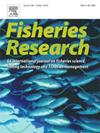Exploring spatiotemporal non-stationarity of the marine environmental impact on skipjack fishery under different climate conditions in the Western and Central Pacific
IF 2.3
2区 农林科学
Q2 FISHERIES
引用次数: 0
Abstract
The skipjack tuna (Katsuwonus pelamis) is a significant fishery resource within purse seine fisheries in the Western and Central Pacific Ocean. The distribution of skipjack resources is influenced by the El Niño-Southern Oscillation (ENSO), exhibiting diverse spatiotemporal impact mechanisms. To investigate the spatiotemporal non-stationarity of how marine environments affect skipjack catch rate under different climate conditions, we applied the geographically and temporally weighted regression (GTWR) model to skipjack catch rate and marine environmental data from 2004 to 2021. We then compared GTWR with geographically weighted regression and generalized additive models to evaluate its validity. The findings reveal: (1) The GTWR model significantly outperformed the other two models, achieving an adjusted R² of 0.63 and exhibiting lower MAE, RMSE, and RSS values, which demonstrates the presence of spatiotemporal non-stationarity. (2) Skipjack catch rate was significantly affected by sea surface salinity and temperature (SSS, SST) as well as net primary production (NPP). Sea level anomaly (SLA) and mixed layer depth (MLD) had a moderate impact, whereas zonal and meridional current velocities (U55, V55) had a relatively minor influence. (3) The impact of environmental factors displayed varying spatial non-stationarity. Spatial non-stationarity was most pronounced for NPP, SSS, and V55, followed by SLA and SST, and least pronounced for MLD and U55. Notably, SLA spatial non-stationarity decreased during normal periods, U55 increased during El Niño, and MLD and V55 increased during La Niña. (4) Due to spatial differences influenced by ENSO, the eastern study area displayed more significant temporal non-stationarity than the western area.
中西太平洋不同气候条件下海洋环境对鲣鱼渔业影响的时空非平稳性研究
鲣鱼(Katsuwonus pelamis)是中西太平洋围网渔业中的重要渔业资源。鲣鱼资源分布受El Niño-Southern涛动(ENSO)的影响,表现出不同的时空影响机制。为了研究不同气候条件下海洋环境对鲣鱼捕捞率的时空非平稳性影响,本文采用地理时间加权回归(GTWR)模型对2004 - 2021年的鲣鱼捕捞率和海洋环境数据进行了分析。然后,我们将GTWR与地理加权回归和广义加性模型进行比较,以评估其有效性。结果表明:(1)GTWR模型显著优于其他两种模型,调整后的R²为0.63,MAE、RMSE和RSS值均较低,表明存在时空非平稳性。(2)海面盐度和温度(SSS、SST)以及净初级产量(NPP)对鲣鱼捕捞率有显著影响。海平面异常(SLA)和混合层深度(MLD)的影响中等,纬向和经向流速(U55、V55)的影响相对较小。(3)环境因子的影响表现出不同的空间非平稳性。NPP、SSS和V55的空间非平稳性最明显,其次是SLA和SST, MLD和U55的空间非平稳性最不明显。值得注意的是,SLA空间非平稳性在正常时期有所下降,U55在El Niño期间有所增加,MLD和V55在La Niña期间有所增加。(4)受ENSO影响的空间差异,东部研究区比西部研究区表现出更显著的时间非平稳性。
本文章由计算机程序翻译,如有差异,请以英文原文为准。
求助全文
约1分钟内获得全文
求助全文
来源期刊

Fisheries Research
农林科学-渔业
CiteScore
4.50
自引率
16.70%
发文量
294
审稿时长
15 weeks
期刊介绍:
This journal provides an international forum for the publication of papers in the areas of fisheries science, fishing technology, fisheries management and relevant socio-economics. The scope covers fisheries in salt, brackish and freshwater systems, and all aspects of associated ecology, environmental aspects of fisheries, and economics. Both theoretical and practical papers are acceptable, including laboratory and field experimental studies relevant to fisheries. Papers on the conservation of exploitable living resources are welcome. Review and Viewpoint articles are also published. As the specified areas inevitably impinge on and interrelate with each other, the approach of the journal is multidisciplinary, and authors are encouraged to emphasise the relevance of their own work to that of other disciplines. The journal is intended for fisheries scientists, biological oceanographers, gear technologists, economists, managers, administrators, policy makers and legislators.
 求助内容:
求助内容: 应助结果提醒方式:
应助结果提醒方式:


